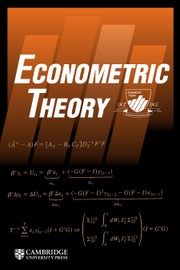Article contents
UNIT ROOT TESTING IN PRACTICE: DEALING WITHUNCERTAINTY OVER THE TREND AND INITIALCONDITION
Published online by Cambridge University Press: 01 June 2009
Abstract
In this paper we focus on two major issues thatsurround testing for a unit root in practice,namely, (i) uncertainty as to whether or not alinear deterministic trend is present in the dataand (ii) uncertainty as to whether the initialcondition of the process is (asymptotically)negligible or not. In each case simple testingprocedures are proposed with the aim of maintaininggood power properties across such uncertainties. Forthe first issue, if the initial condition isnegligible, quasi-differenced (QD) detrended(demeaned) Dickey–Fuller-type unit root tests arenear asymptotically efficient when a deterministictrend is (is not) present in the data generatingprocess. Consequently, we compare a variety ofstrategies that aim to select the detrended variantwhen a trend is present, and the demeaned variantotherwise. Based on asymptotic and finite-sampleevidence, we recommend a simple union ofrejections-based decision rule whereby the unit rootnull hypothesis is rejected whenever either of thedetrended or demeaned unit root tests yields arejection. Our results show that this approachgenerally outperforms more sophisticated strategiesbased on auxiliary methods of trend detection. Forthe second issue, we again recommend a union ofrejections decision rule, rejecting the unit rootnull if either of the QD or ordinary least squares(OLS) detrended/demeaned Dickey–Fuller-type testsrejects. This procedure is also shown to performwell in practice, simultaneously exploiting thesuperior power of the QD (OLS) detrended/demeanedtest for small (large) initial conditions.
Information
- Type
- Article Commentary
- Information
- Copyright
- Copyright © Cambridge University Press 2009
Footnotes
We are extremely grateful to Peter Phillips andfive anonymous referees for their helpful andencouraging comments on the scope and content ofearlier drafts of this paper. These have enabledus to make significant improvements to thepaper.
References
REFERENCES
- 97
- Cited by

